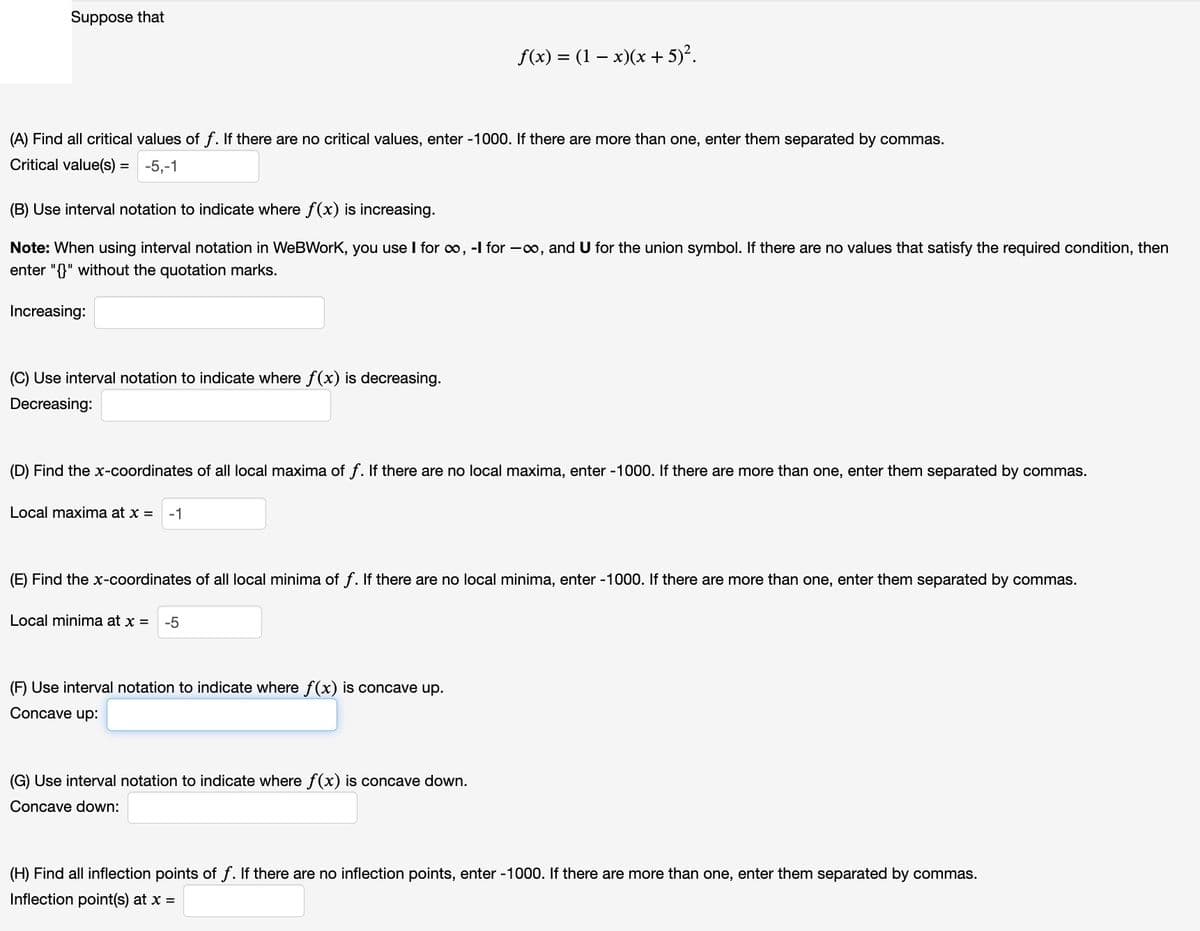Suppose that f(x) = (1 − x)(x+5)². (A) Find all critical values of f. If there are no critical values, enter -1000. If there are more than one, enter them separated by commas. Critical value(s) = -5,-1 (B) Use interval notation to indicate where f(x) is increasing. Note: When using interval notation in WeBWorK, you use I for ∞, -l for -∞, and U for the union symbol. If there are no values that satisfy the required condition, then enter "{}" without the quotation marks. Increasing: (C) Use interval notation to indicate where f(x) is decreasing. Decreasing: (D) Find the x-coordinates of all local maxima of f. If there are no local maxima, enter -1000. If there are more than one, enter them separated by commas. Local maxima at x = -1 (E) Find the x-coordinates of all local minima of f. If there are no local minima, enter -1000. If there are more than one, enter them separated by commas. Local minima at x = -5 (F) Use interval notation to indicate where f(x) is concave up. Concave up: (G) Use interval notation to indicate where f(x) is concave down. Concave down: (H) Find all inflection points of f. If there are no inflection points, enter -1000. If there are more than one, enter them separated by commas. Inflection point(s) at x =
Suppose that f(x) = (1 − x)(x+5)². (A) Find all critical values of f. If there are no critical values, enter -1000. If there are more than one, enter them separated by commas. Critical value(s) = -5,-1 (B) Use interval notation to indicate where f(x) is increasing. Note: When using interval notation in WeBWorK, you use I for ∞, -l for -∞, and U for the union symbol. If there are no values that satisfy the required condition, then enter "{}" without the quotation marks. Increasing: (C) Use interval notation to indicate where f(x) is decreasing. Decreasing: (D) Find the x-coordinates of all local maxima of f. If there are no local maxima, enter -1000. If there are more than one, enter them separated by commas. Local maxima at x = -1 (E) Find the x-coordinates of all local minima of f. If there are no local minima, enter -1000. If there are more than one, enter them separated by commas. Local minima at x = -5 (F) Use interval notation to indicate where f(x) is concave up. Concave up: (G) Use interval notation to indicate where f(x) is concave down. Concave down: (H) Find all inflection points of f. If there are no inflection points, enter -1000. If there are more than one, enter them separated by commas. Inflection point(s) at x =
College Algebra (MindTap Course List)
12th Edition
ISBN:9781305652231
Author:R. David Gustafson, Jeff Hughes
Publisher:R. David Gustafson, Jeff Hughes
Chapter3: Functions
Section3.3: More On Functions; Piecewise-defined Functions
Problem 99E: Determine if the statemment is true or false. If the statement is false, then correct it and make it...
Question

Transcribed Image Text:Suppose that
f(x) = (1 − x)(x+5)².
(A) Find all critical values of f. If there are no critical values, enter -1000. If there are more than one, enter them separated by commas.
Critical value(s) = -5,-1
(B) Use interval notation to indicate where f(x) is increasing.
Note: When using interval notation in WeBWorK, you use I for ∞, -l for -∞, and U for the union symbol. If there are no values that satisfy the required condition, then
enter "{}" without the quotation marks.
Increasing:
(C) Use interval notation to indicate where f(x) is decreasing.
Decreasing:
(D) Find the x-coordinates of all local maxima of f. If there are no local maxima, enter -1000. If there are more than one, enter them separated by commas.
Local maxima at x =
-1
(E) Find the x-coordinates of all local minima of f. If there are no local minima, enter -1000. If there are more than one, enter them separated by commas.
Local minima at x = -5
(F) Use interval notation to indicate where f(x) is concave up.
Concave up:
(G) Use interval notation to indicate where f(x) is concave down.
Concave down:
(H) Find all inflection points of f. If there are no inflection points, enter -1000. If there are more than one, enter them separated by commas.
Inflection point(s) at x =
Expert Solution
This question has been solved!
Explore an expertly crafted, step-by-step solution for a thorough understanding of key concepts.
Step by step
Solved in 2 steps with 4 images

Recommended textbooks for you

College Algebra (MindTap Course List)
Algebra
ISBN:
9781305652231
Author:
R. David Gustafson, Jeff Hughes
Publisher:
Cengage Learning

Algebra & Trigonometry with Analytic Geometry
Algebra
ISBN:
9781133382119
Author:
Swokowski
Publisher:
Cengage

Linear Algebra: A Modern Introduction
Algebra
ISBN:
9781285463247
Author:
David Poole
Publisher:
Cengage Learning

College Algebra (MindTap Course List)
Algebra
ISBN:
9781305652231
Author:
R. David Gustafson, Jeff Hughes
Publisher:
Cengage Learning

Algebra & Trigonometry with Analytic Geometry
Algebra
ISBN:
9781133382119
Author:
Swokowski
Publisher:
Cengage

Linear Algebra: A Modern Introduction
Algebra
ISBN:
9781285463247
Author:
David Poole
Publisher:
Cengage Learning


College Algebra
Algebra
ISBN:
9781305115545
Author:
James Stewart, Lothar Redlin, Saleem Watson
Publisher:
Cengage Learning